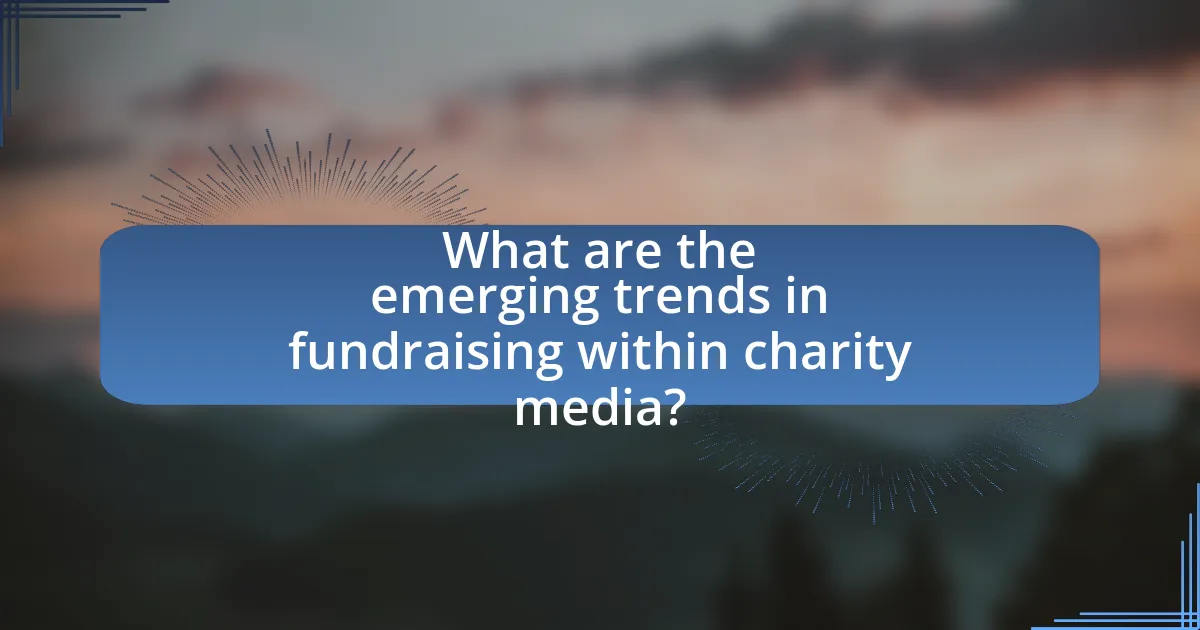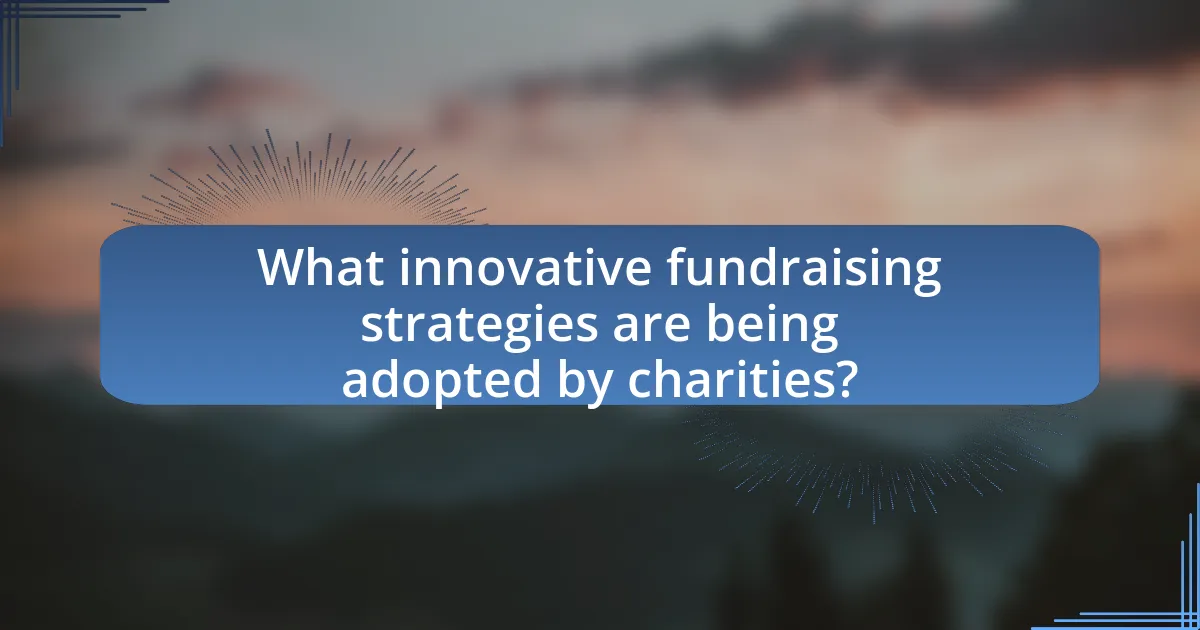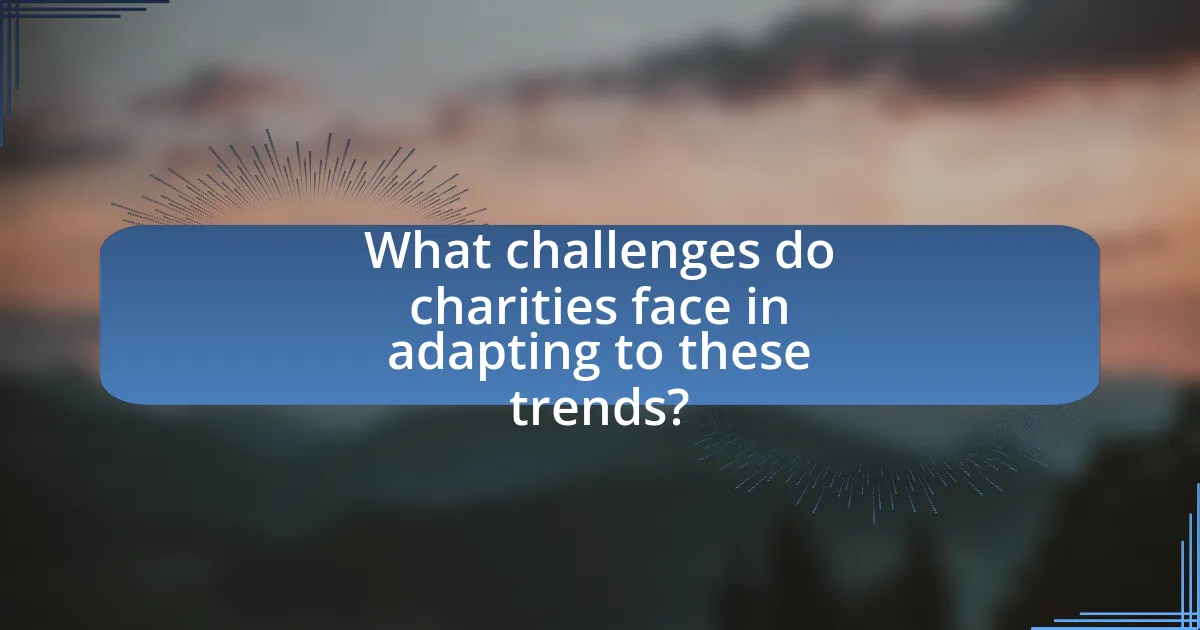The article focuses on emerging trends in fundraising within charity media, highlighting the increasing reliance on digital platforms, personalized donor engagement, and the effectiveness of social media campaigns. It discusses how technology is shaping fundraising by enhancing donor interactions and streamlining donation processes, with a notable rise in online donations. The piece also examines the shifting donor demographics, particularly the influence of younger generations, and emphasizes the importance of transparency and storytelling in building donor connections. Additionally, it addresses the challenges charities face in adapting to these trends and offers best practices for creating comprehensive fundraising strategies that leverage new technologies and data analytics.

What are the emerging trends in fundraising within charity media?
Emerging trends in fundraising within charity media include the increased use of digital platforms, personalized donor engagement, and the integration of social media campaigns. Digital platforms have become essential, with 70% of charities reporting a rise in online donations, particularly during the COVID-19 pandemic. Personalized donor engagement leverages data analytics to tailor communication and appeals, resulting in higher donor retention rates. Additionally, social media campaigns are increasingly utilized, with 54% of nonprofits indicating that social media is their most effective fundraising tool, allowing for broader reach and community involvement. These trends reflect a shift towards more interactive and data-driven approaches in charity fundraising.
How is technology shaping the future of fundraising?
Technology is significantly shaping the future of fundraising by enhancing donor engagement and streamlining the donation process. Digital platforms, such as crowdfunding websites and social media, enable organizations to reach a broader audience and facilitate real-time interactions with potential donors. For instance, according to a report by the Charitable Giving Report 2022, online donations increased by 23% in 2021, highlighting the growing reliance on digital channels for fundraising efforts. Additionally, advancements in payment technologies, such as mobile wallets and cryptocurrency, provide donors with more flexible and secure options for contributing, further driving fundraising success.
What role do social media platforms play in fundraising efforts?
Social media platforms play a crucial role in fundraising efforts by providing a wide-reaching and cost-effective means for organizations to engage potential donors. These platforms facilitate direct communication and interaction between charities and their supporters, allowing for real-time updates and storytelling that can inspire giving. According to a 2021 report by the Pew Research Center, 69% of adults in the U.S. use social media, which significantly expands the audience for fundraising campaigns. Furthermore, studies show that campaigns utilizing social media can raise up to 30% more funds compared to traditional methods, highlighting the effectiveness of these platforms in mobilizing support and increasing donations.
How are mobile applications transforming donor engagement?
Mobile applications are transforming donor engagement by providing real-time communication, personalized experiences, and streamlined donation processes. These applications enable organizations to connect with donors instantly through push notifications, updates on fundraising campaigns, and impact stories, fostering a sense of community and involvement. For instance, a study by the Charitable Giving Report indicated that mobile donations increased by 29% in 2020, highlighting the effectiveness of mobile platforms in facilitating contributions. Additionally, features such as recurring donation options and social sharing capabilities enhance user experience and encourage ongoing support, making mobile applications a crucial tool in modern fundraising strategies.
What changes are occurring in donor demographics?
Donor demographics are shifting towards younger, more diverse populations. Recent studies indicate that millennials and Gen Z are increasingly becoming significant contributors, with 84% of millennials reporting they donate to charities, compared to 70% of baby boomers. Additionally, there is a growing trend of racial and ethnic diversity among donors, with more individuals from various backgrounds engaging in philanthropy, reflecting broader societal changes. This shift is supported by data from the 2021 Giving USA report, which highlights that younger donors are more likely to support causes aligned with social justice and environmental issues, indicating a change in the motivations behind giving.
How are younger generations influencing fundraising strategies?
Younger generations are significantly influencing fundraising strategies by prioritizing digital engagement and social media platforms for outreach. This shift is evident as studies show that 70% of millennials prefer to donate online, highlighting their comfort with technology and preference for convenience. Additionally, younger donors often seek transparency and impact, leading organizations to adopt more data-driven approaches and share real-time updates on fundraising outcomes. This generational focus on authenticity and social responsibility is reshaping how charities communicate their missions and engage potential donors, ultimately driving innovative fundraising campaigns that resonate with a tech-savvy audience.
What are the expectations of modern donors regarding transparency?
Modern donors expect high levels of transparency from organizations regarding how their contributions are utilized. This expectation includes detailed reporting on financial allocations, program outcomes, and the impact of donations, as evidenced by a 2021 survey from the Charities Aid Foundation, which found that 76% of donors prioritize transparency in financial reporting. Additionally, donors seek open communication about organizational governance and decision-making processes, reflecting a broader trend towards accountability in the nonprofit sector.
Why is storytelling becoming essential in charity media fundraising?
Storytelling is becoming essential in charity media fundraising because it effectively engages donors by creating emotional connections to the cause. Research indicates that narratives can increase empathy and understanding, leading to higher donation rates; for instance, a study by the Stanford Graduate School of Business found that people are more likely to donate when they hear a personal story rather than just statistics. This emotional resonance not only captures attention but also fosters a sense of community and shared purpose, making donors feel more invested in the outcomes of their contributions.
How can effective storytelling enhance donor connections?
Effective storytelling enhances donor connections by creating emotional engagement and fostering a sense of belonging. When organizations share compelling narratives about their mission and impact, they resonate with donors on a personal level, making them feel more connected to the cause. Research indicates that stories can increase donor retention rates by up to 50%, as they help individuals visualize the difference their contributions make. For instance, a study by the Stanford Graduate School of Business found that narratives can significantly influence people’s willingness to donate, as they evoke empathy and motivate action. This emotional connection ultimately leads to stronger, long-lasting relationships between donors and organizations.
What are the best practices for crafting compelling narratives?
The best practices for crafting compelling narratives include understanding your audience, creating emotional connections, and using a clear structure. Understanding your audience allows you to tailor your message to their values and interests, which increases engagement. Emotional connections can be established through storytelling techniques that evoke empathy, such as sharing personal experiences or impactful testimonials. A clear structure, typically involving a beginning that sets the scene, a middle that presents challenges, and an end that offers resolution, helps maintain clarity and keeps the audience invested. Research indicates that narratives that follow this structure are more memorable and persuasive, as demonstrated in studies by the Stanford Graduate School of Business, which found that stories can significantly enhance the effectiveness of communication in fundraising contexts.

What innovative fundraising strategies are being adopted by charities?
Charities are adopting innovative fundraising strategies such as crowdfunding, virtual events, and social media campaigns. Crowdfunding platforms enable charities to reach a wider audience and gather small donations from many individuals, significantly increasing their fundraising potential. Virtual events, which gained popularity during the COVID-19 pandemic, allow charities to engage supporters through online activities, such as webinars and live-streamed auctions, thus reducing costs associated with physical events. Social media campaigns leverage platforms like Instagram and Facebook to create viral fundraising initiatives, encouraging peer-to-peer sharing and engagement. According to a report by the Charitable Giving Report 2023, online donations have increased by 23% since 2020, highlighting the effectiveness of these strategies in reaching new donors and enhancing fundraising efforts.
How are virtual events changing the landscape of fundraising?
Virtual events are transforming the landscape of fundraising by expanding reach and accessibility for both organizations and donors. These online platforms allow charities to engage a global audience, breaking geographical barriers that traditional in-person events face. For instance, a report from Nonprofit Source indicates that 70% of nonprofits have shifted to virtual events, resulting in increased participation and donations from individuals who may not have attended physical events due to distance or other constraints. Additionally, virtual events often have lower overhead costs, enabling organizations to allocate more funds directly to their causes. This shift not only enhances donor engagement through interactive features but also provides valuable data analytics to optimize future fundraising strategies.
What types of virtual events are most successful for charities?
The most successful types of virtual events for charities include online auctions, virtual galas, and crowdfunding campaigns. Online auctions allow charities to engage donors by offering unique items and experiences, often resulting in higher bids due to competitive bidding. Virtual galas replicate the traditional gala experience, providing entertainment and emotional storytelling, which can significantly boost donations; for instance, a study by the Association of Fundraising Professionals found that virtual galas raised an average of 30% more than in-person events during the pandemic. Crowdfunding campaigns leverage social media to reach a broader audience, encouraging small donations that can accumulate to substantial amounts; platforms like GoFundMe have reported millions raised for various causes through this method.
How can charities maximize engagement during virtual events?
Charities can maximize engagement during virtual events by incorporating interactive elements such as live polls, Q&A sessions, and breakout rooms. These features encourage participant involvement and create a sense of community, which is crucial for maintaining interest. Research indicates that events with interactive components see up to 70% higher engagement rates compared to traditional formats. Additionally, utilizing social media platforms for real-time updates and discussions can further enhance audience interaction, as evidenced by a study from the Nonprofit Technology Network, which found that organizations leveraging social media during events experienced a 50% increase in participant engagement.
What role does influencer marketing play in charity fundraising?
Influencer marketing plays a significant role in charity fundraising by leveraging the reach and credibility of social media influencers to engage audiences and drive donations. Influencers can amplify a charity’s message, reaching diverse demographics that traditional marketing may not effectively target. For instance, a study by the Nonprofit Marketing Guide found that 70% of nonprofits reported increased donations when utilizing influencer partnerships. This demonstrates that influencers can enhance visibility and trust, leading to higher engagement and financial support for charitable causes.
How can charities effectively collaborate with influencers?
Charities can effectively collaborate with influencers by establishing clear goals, aligning values, and creating authentic partnerships. Charities should identify influencers whose audience matches their target demographic and whose values resonate with their mission. For instance, a charity focused on environmental issues may partner with eco-conscious influencers to amplify their message. Additionally, charities should engage influencers in meaningful ways, such as co-creating content or involving them in fundraising events, which fosters authenticity and encourages genuine support. Research indicates that campaigns featuring authentic influencer partnerships can increase engagement rates by up to 11 times compared to traditional marketing methods, demonstrating the effectiveness of these collaborations.
What are the potential risks and rewards of influencer partnerships?
Influencer partnerships can yield significant rewards, such as increased brand visibility and access to targeted audiences, but they also carry risks, including potential damage to brand reputation and misalignment with audience values. The rewards stem from influencers’ ability to engage their followers authentically, which can lead to higher conversion rates; for instance, a study by the Digital Marketing Institute found that 49% of consumers depend on influencer recommendations. Conversely, risks include the possibility of influencers behaving in ways that conflict with brand values, as seen in cases where influencers faced backlash for controversial statements, leading to negative publicity for associated brands.
Why is data analytics crucial for future fundraising efforts?
Data analytics is crucial for future fundraising efforts because it enables organizations to make data-driven decisions that enhance donor engagement and optimize fundraising strategies. By analyzing donor behavior, preferences, and trends, organizations can tailor their campaigns to meet the specific needs of their audience, leading to increased donations. For instance, a study by the Association of Fundraising Professionals found that organizations using data analytics saw a 20% increase in donor retention rates. This demonstrates that leveraging data analytics not only improves fundraising outcomes but also fosters long-term relationships with donors.
How can charities leverage data to improve fundraising outcomes?
Charities can leverage data to improve fundraising outcomes by utilizing donor analytics to identify trends and preferences among their supporters. By analyzing past donation patterns, demographics, and engagement levels, charities can tailor their outreach strategies to target specific donor segments more effectively. For instance, a study by the Association of Fundraising Professionals found that organizations using data-driven strategies saw a 20% increase in donor retention rates. Additionally, employing predictive modeling can help charities forecast future giving behaviors, allowing them to optimize their campaigns and allocate resources more efficiently. This data-centric approach not only enhances personalization but also increases the likelihood of successful fundraising initiatives.
What tools are available for analyzing donor behavior?
Tools available for analyzing donor behavior include donor management software, predictive analytics platforms, and customer relationship management (CRM) systems. Donor management software, such as DonorPerfect and Bloomerang, allows organizations to track donations, manage donor information, and analyze giving patterns. Predictive analytics platforms, like Blackbaud and Salesforce, utilize data modeling to forecast future giving behavior based on historical data. CRM systems, such as HubSpot and Zoho, help organizations manage interactions with donors and analyze engagement metrics. These tools enable nonprofits to make data-driven decisions, enhancing fundraising strategies and improving donor retention.

What challenges do charities face in adapting to these trends?
Charities face significant challenges in adapting to emerging trends in fundraising and media. One major challenge is the rapid evolution of technology, which requires charities to continuously update their digital platforms and strategies to engage donors effectively. For instance, a 2021 report by the Charitable Giving Report indicated that online donations increased by 21% in 2020, highlighting the necessity for charities to enhance their online presence and digital marketing efforts. Additionally, competition for donor attention has intensified, as numerous organizations vie for limited resources, making it crucial for charities to differentiate their messaging and outreach strategies. Furthermore, changing donor demographics and preferences necessitate that charities understand and cater to the expectations of younger generations, who often prefer transparency and social impact over traditional fundraising methods. These factors collectively create a complex landscape that charities must navigate to remain relevant and effective in their fundraising efforts.
How can charities overcome technological barriers in fundraising?
Charities can overcome technological barriers in fundraising by investing in user-friendly digital platforms and providing training for staff and volunteers. User-friendly platforms, such as mobile-friendly donation pages and social media fundraising tools, enhance accessibility and engagement, leading to increased donations. A study by the Charitable Giving Report indicates that organizations utilizing optimized online donation systems saw a 30% increase in contributions compared to those relying on traditional methods. Additionally, training staff and volunteers on these technologies ensures effective use and maximizes fundraising potential, as evidenced by organizations that reported improved fundraising outcomes after implementing comprehensive training programs.
What resources are available for charities to enhance their tech capabilities?
Charities can enhance their tech capabilities through various resources, including grants, training programs, and partnerships with tech companies. For instance, organizations like TechSoup provide discounted software and hardware specifically for nonprofits, while the Google for Nonprofits program offers free access to tools such as Google Workspace and advertising credits. Additionally, platforms like Catchafire connect charities with skilled volunteers who can assist in tech projects, thereby improving their technological infrastructure. These resources are essential for charities to adapt to the evolving digital landscape and improve their fundraising efforts.
How can smaller charities compete with larger organizations in fundraising?
Smaller charities can compete with larger organizations in fundraising by leveraging their unique community connections and focusing on personalized donor engagement. These charities often have the advantage of being more agile, allowing them to quickly adapt their fundraising strategies to meet the specific needs and interests of their local supporters. For instance, smaller charities can utilize social media platforms effectively to create targeted campaigns that resonate with their audience, fostering a sense of community and loyalty. Research indicates that 70% of donors prefer to support local causes, highlighting the potential for smaller charities to capitalize on their local presence and relationships. By emphasizing transparency, storytelling, and direct communication, smaller charities can build trust and encourage repeat donations, making them competitive in the fundraising landscape.
What ethical considerations must be addressed in modern fundraising?
Modern fundraising must address transparency, donor privacy, and the ethical use of funds. Transparency involves clearly communicating how donations are utilized, which builds trust and accountability; for instance, organizations that disclose their financial reports often see increased donor confidence. Donor privacy is crucial, as mishandling personal information can lead to breaches of trust and legal repercussions; the General Data Protection Regulation (GDPR) emphasizes the importance of safeguarding donor data. Lastly, the ethical use of funds requires that organizations allocate resources effectively and avoid misleading claims about the impact of donations, as evidenced by the Better Business Bureau’s Standards for Charity Accountability, which promote responsible fundraising practices.
How can charities ensure they maintain donor trust and integrity?
Charities can maintain donor trust and integrity by ensuring transparency in their operations and financial reporting. Transparency builds confidence among donors, as it allows them to see how their contributions are utilized. For instance, a study by the Charities Aid Foundation found that 73% of donors are more likely to give to organizations that provide clear information about their financial health and impact. Additionally, charities should engage in regular communication with donors, providing updates on projects and outcomes, which fosters a sense of involvement and accountability. Implementing strong ethical guidelines and adhering to them also reinforces trust, as it demonstrates a commitment to integrity in all dealings.
What are the implications of data privacy on fundraising practices?
Data privacy significantly impacts fundraising practices by necessitating stricter compliance with regulations such as GDPR and CCPA. These regulations require organizations to obtain explicit consent from donors before collecting and using their personal data, which can limit the scope of fundraising strategies. For instance, a study by the International Association of Fundraising Professionals indicates that 70% of donors are concerned about how their data is used, leading to a demand for transparency and ethical data handling. Consequently, organizations must invest in secure data management systems and adopt transparent communication strategies to build trust with potential donors, ultimately affecting their fundraising effectiveness.
What are the best practices for charities to implement these trends effectively?
Charities should adopt a multi-channel approach to effectively implement fundraising trends. This involves utilizing various platforms such as social media, email marketing, and crowdfunding to reach diverse audiences. Research indicates that organizations using multi-channel strategies see a 20% increase in donor engagement compared to single-channel approaches. Additionally, charities should leverage data analytics to understand donor behavior and preferences, allowing for personalized communication that enhances donor relationships. A study by Blackbaud found that personalized outreach can increase donation amounts by up to 10%. Furthermore, integrating storytelling into campaigns can significantly boost emotional connections with potential donors, as narratives have been shown to increase fundraising success rates by 30%. By focusing on these best practices, charities can effectively navigate and capitalize on emerging trends in fundraising.
How can charities create a comprehensive fundraising strategy that incorporates new trends?
Charities can create a comprehensive fundraising strategy that incorporates new trends by leveraging digital platforms, engaging with social media influencers, and utilizing data analytics to understand donor behavior. Digital platforms, such as crowdfunding websites and mobile giving apps, have seen a significant increase in usage, with online donations growing by 21% in 2020 according to the Blackbaud Institute. Engaging social media influencers can amplify outreach, as 49% of consumers depend on influencer recommendations for their purchasing decisions, which can translate to donations. Additionally, employing data analytics allows charities to tailor their campaigns based on donor preferences and trends, enhancing engagement and increasing fundraising effectiveness.
What steps should charities take to engage and retain donors in the evolving landscape?
Charities should adopt a multi-channel communication strategy to engage and retain donors in the evolving landscape. This approach includes utilizing social media, email marketing, and personalized outreach to create meaningful connections with supporters. Research indicates that 70% of donors prefer to receive updates via email, while 60% engage with organizations through social media platforms. Additionally, implementing donor recognition programs and providing transparent reporting on the impact of donations can significantly enhance donor loyalty. A study by the Association of Fundraising Professionals found that organizations that regularly communicate their impact see a 25% increase in donor retention rates.


